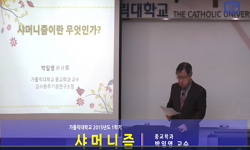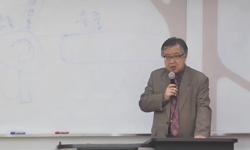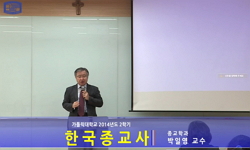이 연구는 샤머니즘의 관점에서 동학경전의 서술구조와 그 사상을 고찰한다. 특히 『동경대전』과 『용담유사』의 주요 문장을 구조적으로 분석하여 그 안에 담긴 주요 사상 개념의 형성 ...
http://chineseinput.net/에서 pinyin(병음)방식으로 중국어를 변환할 수 있습니다.
변환된 중국어를 복사하여 사용하시면 됩니다.
- 中文 을 입력하시려면 zhongwen을 입력하시고 space를누르시면됩니다.
- 北京 을 입력하시려면 beijing을 입력하시고 space를 누르시면 됩니다.

샤머니즘을 통해서 본 동학 경전의 구조와 사상 = A Study on the Structure and Thought of Donghak Scriptures through Shamanism
한글로보기https://www.riss.kr/link?id=A108172172
- 저자
- 발행기관
- 학술지명
- 권호사항
-
발행연도
2022
-
작성언어
-
-
주제어
최제우 ; 동학 ; 동경대전 ; 용담유사 ; 샤머니즘 ; 신비체험 ; Donghak ; scriptures ; Donggyoung-Daejeon ; Yongdam-Yusa ; Choi Jae-woo ; shamanism ; mystical experience
-
등재정보
KCI등재
-
자료형태
학술저널
- 발행기관 URL
-
수록면
133-164(32쪽)
- DOI식별코드
- 제공처
-
0
상세조회 -
0
다운로드
부가정보
국문 초록 (Abstract)
이 연구는 샤머니즘의 관점에서 동학경전의 서술구조와 그 사상을 고찰한다. 특히 『동경대전』과 『용담유사』의 주요 문장을 구조적으로 분석하여 그 안에 담긴 주요 사상 개념의 형성 시기와 그 의미를 규명하고자 하였다. 본문에서 논한 몇 가지 사항을 정리하자면 다음과 같다.
첫째, 1980년대 이후 학계에서는 최제우 자신이 샤먼의 트랜스 체험을 한 바 있으며 그의 여러 가지 종교 활동을 샤먼의 활동으로 볼 수 있다는 주장이 주류를 형성하게 되었다. 즉 동학 경전 안에 담긴 샤머니즘적인 관념이 의도적으로 만들어진 것이 아니라 자연스러운 무속문화의 반영이라고 보는 견해가 많아지게 되었다.
둘째, 최제우의 대표적인 문장 예를 들면 「용담가」(1860년), 「포덕문」(1861년), 「안심가」(1861년), 「교훈가」(1861년), 「수덕문」(1862년), 「몽중노소문답가」(1862년)에는 최제우 자신이 1860년 4월 5일에 경험한 신비체험(득도체험)이 묘사되어 있다. 그 내용을 살펴보면 체험의 준비 → 신과 만남 → 신과의 영적인 교류(대화) → 체험의 마무리 과정이 상세하게 혹은 간략하게 그려져 있다.
셋째, 최제우 동학사상을 형성하는 주요 개념은 신과의 영적인 교류와 마무리 과정 중에 주로 등장한다. 이는 그의 사상이 신비체험을 통해 신과의 만남으로써 형성된 것이라는 점을 의미한다. 그러한 만남을 통해서 그는 스스로를 이 세상의 중심적 존재로 여기게 되었으며 이러한 인식이 사회적, 국가적으로 확대됨으로써 동학사상의 모습이 형성된 것이라고 할 수 있다.
다국어 초록 (Multilingual Abstract)
This study examines the narrative structure and ideas of the Donghak scriptures through shamanism. Specifically, the main texts of Donggyeong-Daejeon and Yongdam-Yusa are structurally analyzed to investigate the formation period of their main concepts...
This study examines the narrative structure and ideas of the Donghak scriptures through shamanism. Specifically, the main texts of Donggyeong-Daejeon and Yongdam-Yusa are structurally analyzed to investigate the formation period of their main concepts and the meaning behind its formation. Several issues are discussed in this work.
First, since the 1980s, the academic world have witnessed the mainstreaming of the idea that Choi Jae-woo entered a trance state like a shaman and his various religious activities can be regarded as a shaman's activities. In other words, many have emphasized that the shamanistic idea in the Donghak scriptures is not intentionally made but is a reflection of natural shamanism.
Second, take for example Choi Je-woo's representative works, such as “Yongdamga” (1860), “Podeokmun” (1861), “Anshimga” (1861), “Kyohunga” (1861), “Sudeokmun” (1862), and “Mongjungnosomundapga” (1862); these works depict the mystical experience experienced by Choi Je-woo himself on April 5, 1860. Essentially, they describe the process of 1) preparing for a mystical experience, 2) meeting with God, 3) engaging in a spiritual exchange (dialogue) with God, and 4) completing the experience. However, the experiences detailed in these works are described differently in each sentence.
Third, as shown in the seven works of Choi Je-woo, the main concept of the Donghak thought was formed during his spiritual exchange with God and upon the conclusion of his mystical experience. Therefore, his ideas were formed by meeting with God through a shamanic experience. However, in line with the characteristics of a shaman's trance experience, the concepts of. This characteristic is attributable to Choi Jae-woo’s experience being closer to an emotional state than to an intellectual one.
In this study, I analyze "Yongdamga" that was written by Choi Jae-woo at an early stage and explain that such an emotional state originated from being recognized by Hanulnim, the supreme god. Thus, self-esteem and the confidence to recognize himself as the central being of this world are the core of the revelations received by Choi Jae-woo. Such revelations expanded socially, forming the base of the Donghak thought that we speak of today.
동일학술지(권/호) 다른 논문
-
서간(徐幹)의 『중론(中論)』에 나타나는 후한 말 효(孝)의 전환
- 동양철학연구회
- 박진우
- 2022
- KCI등재
-
中庸 미학에서 生生 미학으로 ― 『시경』을 중심으로 ―
- 동양철학연구회
- 辛正根 ( Shin Jeong-geun )
- 2022
- KCI등재
-
- 동양철학연구회
- 이순미 ( Lee Soonmi )
- 2022
- KCI등재
-
장재 지식론의 특징과 그 모호성 ― 견문지와 덕성지의 문제를 중심으로 ―
- 동양철학연구회
- 황종원 ( Hwang Jong-won )
- 2022
- KCI등재




 KCI
KCI KISS
KISS






